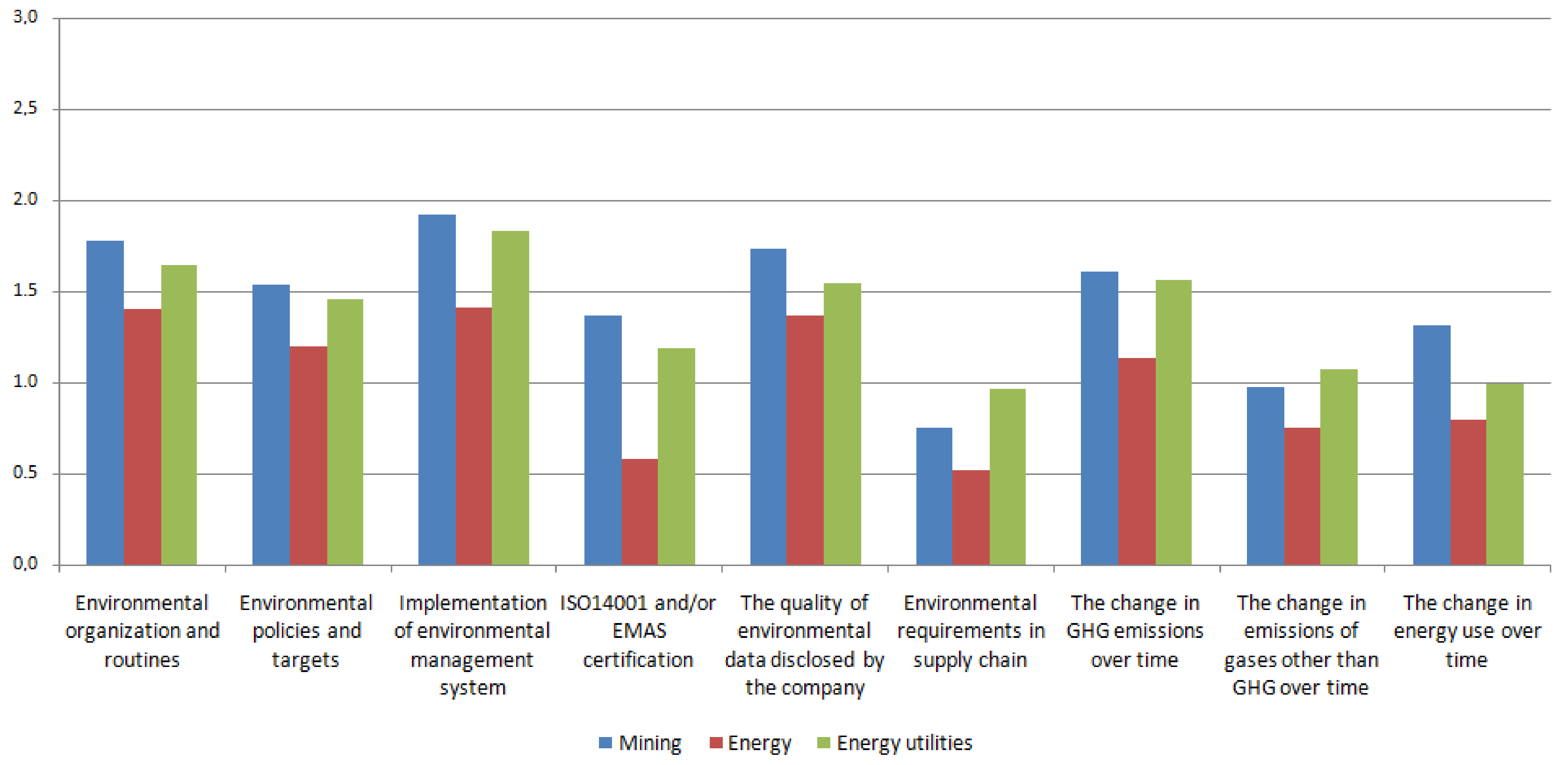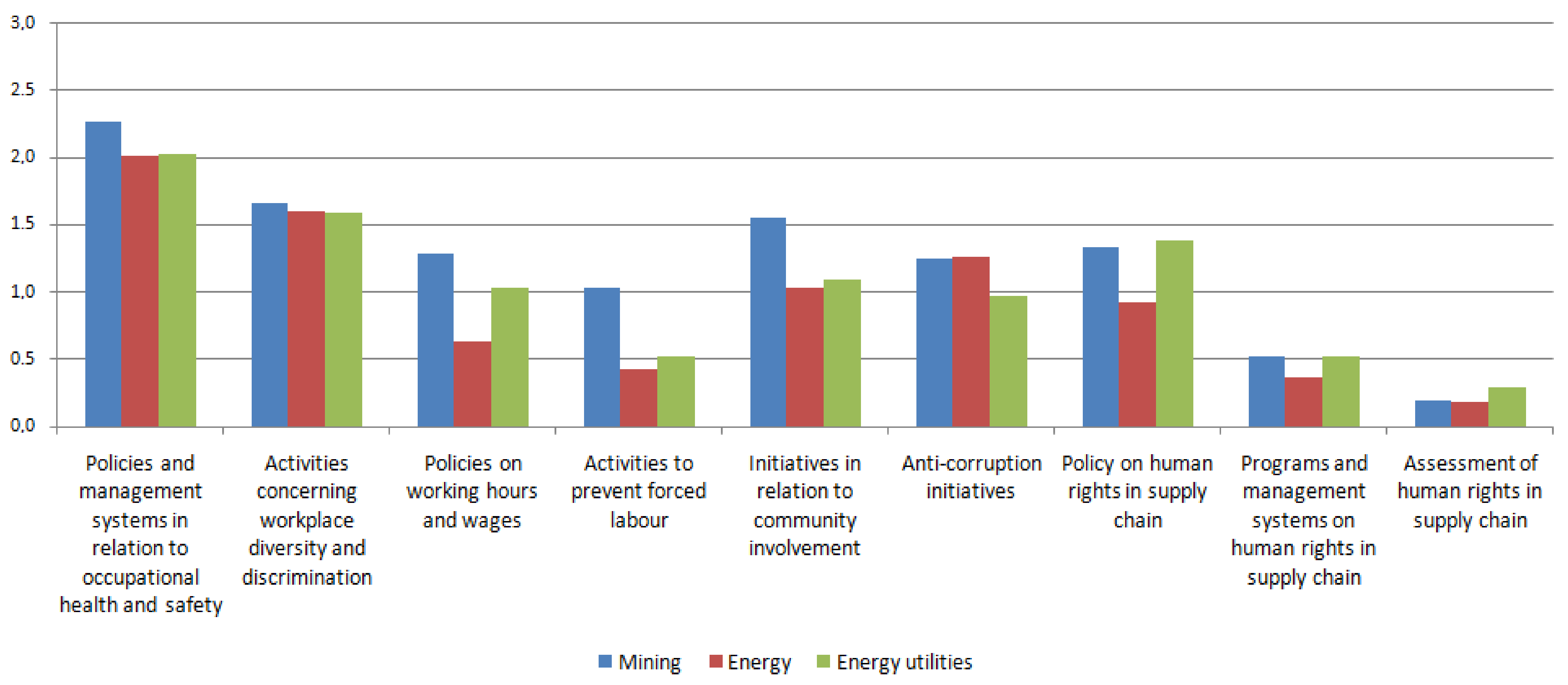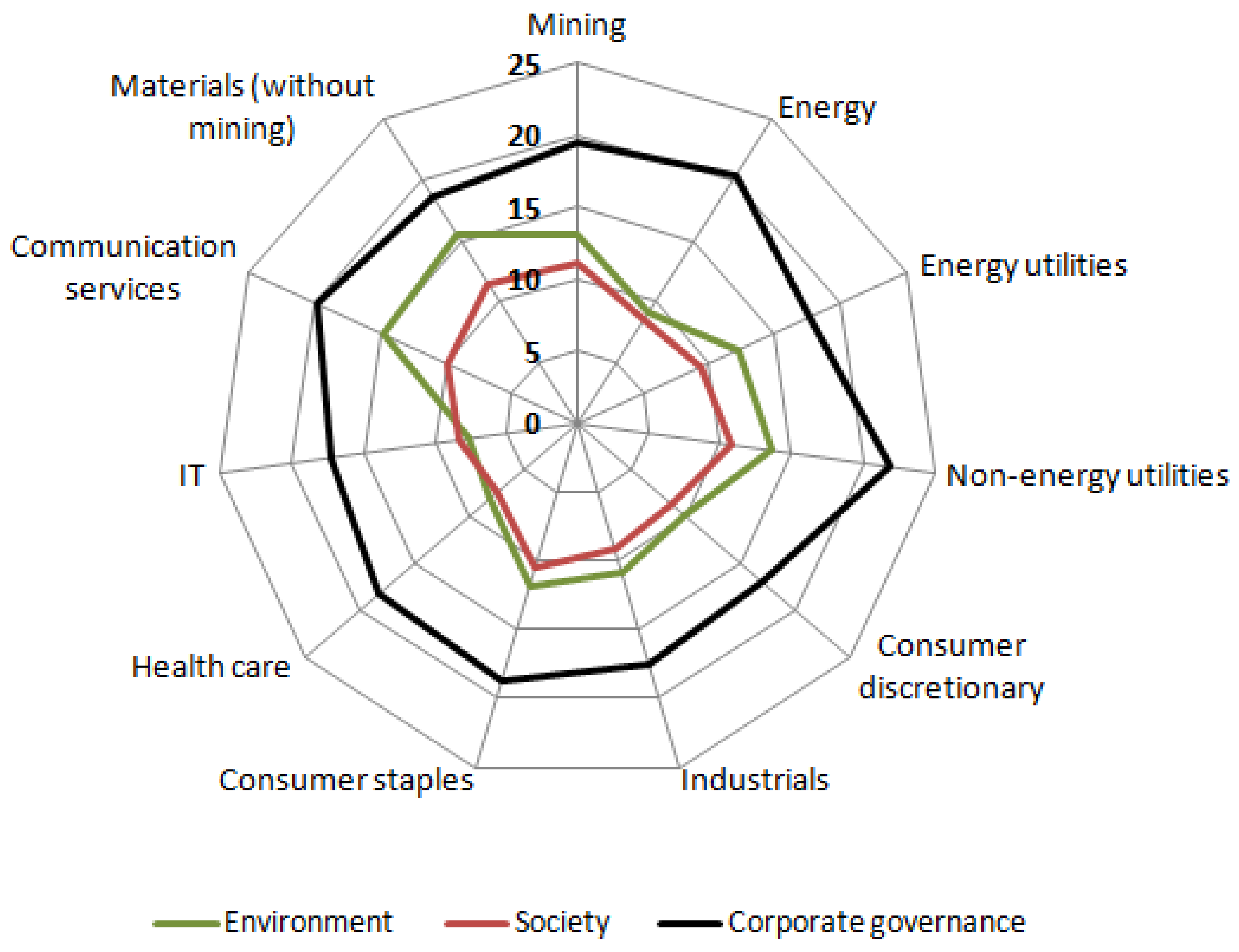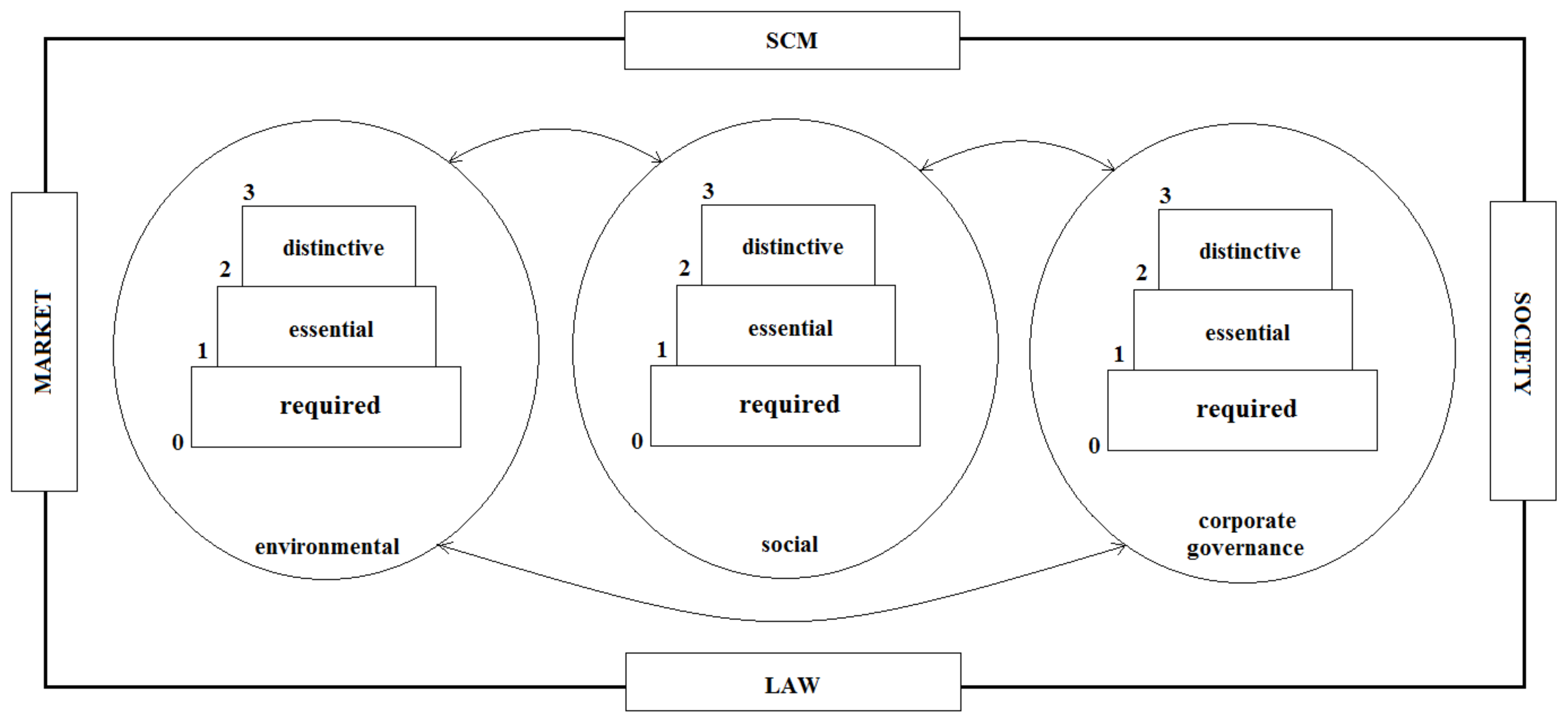Selected Aspects of Corporate Social Responsibility in the Industry Related to the Production and Supply of Energy
Abstract
:1. Introduction
- (1)
- Which factors, in terms of environmental, social, and corporate governance aspects, affect the level of CSR implementation?
- (2)
- Does the level of implementation of CSR concepts in the energy industry differ from other sectors?
- (3)
- Which is the biggest problem in the field of CSR in the energy industry?
- (4)
- What factors affect the level of implementation of the CSR concept in the energy industry?
2. Corporate Social Responsibility—Idea and Application Possibilities
- a reduction of at least 40% in greenhouse gas emissions compared to 1990 levels;
- increasing the share of renewable energy in all consumed energy sources to 32%;
- improvement of energy efficiency by 32.5%;
- interconnections covering at least 15% of the EU’s electricity systems.
3. Materials and Methods
- −
- mining companies extract fossil fuels for further use.
- −
- the group of energy produces energy and energy utilities distributes energy to end users. From a technical point of view, the energy group is a sector according to GICS.
- −
- energy utilities is a group created for the needs of research by including following industries from GICS utilities sector: gas utilities, electric utilities, independent power, and renewable electricity producers. Other utilities: multi-utilities and water utilities established the group of non-energy utilities. In GICS, mining companies are a part of materials sector. For the needs of this research, they are considered separately.
- −
- environmental organization and routines;
- −
- environmental policies and targets;
- −
- implementation of environmental management system;
- −
- ISO14001 and/or EMAS certification;
- −
- the quality of environmental data disclosed by the company;
- −
- environmental requirements in supply chain;
- −
- the change in GHG emissions over time;
- −
- the change in emissions of gases other than GHG over time;
- −
- the change in energy use over time.
- −
- policies and management systems in relation to occupational health and safety;
- −
- activities concerning workplace diversity and discrimination;
- −
- policies on working hours and wages;
- −
- activities to prevent forced labour;
- −
- initiatives in relation to community involvement;
- −
- anti-corruption initiatives;
- −
- policy on human rights in supply chain;
- −
- programs and management systems on human rights in supply chain;
- −
- assessment of human rights in supply chain.
- −
- the independence of the board of directors;
- −
- gender parity in the board of directors;
- −
- composition and independence of the nomination committee;
- −
- composition and independence of the audit committee;
- −
- composition and independence of the compensation committee;
- −
- transparency in relation to corporate governance code;
- −
- transparency about CEO’s compensation;
- −
- transparency about auditors’ compensation;
- −
- providing information on the company’s board members.
4. Results
- Step (1): Analysis of CSR—environmental;
- Step (2): Analysis of CSR—society;
- Step (3): Analysis of CSR—corporate governance;
- Step (4): Comparative analysis of selected energy sectors with other sectors.
4.1. Groups of Mining, Energy, and Energy Utilities in the Area of Environment
Environment
4.2. Groups of Mining, Energy, and Energy Utilities in the Area of Society
Society
4.3. Group of Mining, Energy, and Energy Utilities in the Area of Corporate Governance
Corporate Governance
4.4. CSR Level in Mining, Energy, and Energy Utilities and Other Sectors of Economy
Comparative Analysis with Other Sectors
5. Discussion
6. Conclusions
Author Contributions
Funding
Institutional Review Board Statement
Informed Consent Statement
Data Availability Statement
Conflicts of Interest
References
- World Commission on Environment and Development. Our Common Future; Oxford University Press: Oxford, UK, 1987; Available online: https://sustainabledevelopment.un.org/content/documents/5987our-common-future.pdf (accessed on 15 July 2021).
- Gore, A. Earth in the Balance; Chelsea Green: New York, NY, USA, 1992. [Google Scholar]
- Norouzi, N.; Ataei, E. Globalization and sustainable development. Int. J. Innov. Res. Humanit. 2021, 1, 69. [Google Scholar]
- Surówka, M.; Popławski, M.; Fidlerová, H. Technical Infrastructure as an Element of Sustainable Development of Rural Regions in Małopolskie Voivodeship in Poland and Trnava Region in Slovakia. Agriculture 2021, 11, 141. [Google Scholar] [CrossRef]
- Kelimeler, A. Constitution and Sustainable Development. İstanbul Hukuk Mecmuası 2020, 78, 1921–1957. [Google Scholar] [CrossRef]
- United Nations. UNGC our Participants. Available online: https://www.unglobalcompact.org/what-is-gc/participants (accessed on 11 August 2020).
- Adamczyk, J. Obszary i kryteria oceny społecznej odpowiedzialności przedsiębiorstw. Pr. Nauk. Uniw. Ekon. We Wrocławiu 2014, 338, 9–19. [Google Scholar] [CrossRef] [Green Version]
- Friedman, M. The Social Responsibility of Business is to Increase Its Increase Its Profits. New York Times Magazine, 13 September 1970; 32–33. [Google Scholar]
- Kang, Y.C.; Wood, D.J. Before Profit Social Responsibility Turning the Economic Paradigm Upside Down. Bus. Soc. 1995, 6, 809–829. [Google Scholar]
- Grffin, R.W. Podstawy Zarządzania Organizacjami; PWE: Warszawa, Poland, 2004. [Google Scholar]
- European Commission “Green Book”. Available online: http://ec.europa.eu/employment_social/soc-dial/csr/greenpaper.htm (accessed on 30 July 2021).
- Carroll, A.B. The Pyramid of Corporate Social Responsibility: Toward the Moral Management of organizational stakeholders. Bus. Horiz. 1991, 34, 39–48. [Google Scholar] [CrossRef]
- Huk, K. Logistyka miejska a społeczna odpowiedzialność biznesu—Wspólne obszary zainteresowania. Stud. Ekon. 2015, 249, 155–163. [Google Scholar]
- Huk, K.; Witkowski, K.; Wasilewski, W. Social aspects of urban logistics in the context of CSR. Logist. Transp. 2016, 3, 13–20. [Google Scholar]
- Garriga, E.; Melé, D. Corporate Social Responsibility Theories: Mapping the Territory. J. Bus. Ethics 2004, 53, 51–71. [Google Scholar] [CrossRef]
- Carroll, A.B. A Three-Dimensional Conceptual Model of Corporate Performance. Acad. Manag. Rev. 1979, 4, 497–505. [Google Scholar] [CrossRef]
- Carroll, A.B. Busieness and Society: Ethics and Stakeholder Management; College Division South-Western Publishing Co.: Cincinaati, OH, USA, 1993. [Google Scholar]
- Drucker, P.F. The New Meaning of Corporate Social Responsibility. Calif. Manag. Rev. 1984, 26, 53–63. [Google Scholar] [CrossRef]
- Sokołowska, A. Społeczna odpowiedzialność małego przedsiębiorstwa—Przejawy i dylematy. E-Mentor 2009, 5, 31–37. [Google Scholar]
- Gableta, M. W kierunku operacjonalizacji pojęcia odpowiedzialności społecznej w obszarze zatrudnienia. In Kierunki i Dylematy Rozwoju Nauki i Praktyki Zarządzania Przedsiębiorstwem; Jagoda, H., Lichtarski, J., Eds.; Wyd. UE We Wrocławiu: Wrocław, Poland, 2010; p. 73. [Google Scholar]
- Stareček, A.; Gyurák Babeľová, Z.; Makyšová, H.; Cagáňová, D. Sustainable Human Resource Management and Generations of Employees in Industrial Enterprises. Acta Logist. 2021, 8, 45–53. [Google Scholar] [CrossRef]
- Adamiak, A.; Nowicki, M. Etyka i społeczna odpowiedzialność biznesu. In Podstawy Zarządzania; Zakrzewska-Bielawska, A., Ed.; Oficyna Wolters Kluwer Business: Warszawa, Poland, 2012; p. 504. [Google Scholar]
- Young, S. Etyczny Kapitalizm. Jak Na Powrót Połączyć Prywatny Interes z Dobrem Publicznym; Metamorfoza: Wrocław, Poland, 2005. [Google Scholar]
- Ackerman, R.W. How Companies Respond to Social Demands. Harv. Univ. Rev. 1973, 51, 88–98. [Google Scholar]
- Jones, T.M. Corporate Social Responsibility Revisited Redefined. Calif. Manag. Rev. 1980, 5, 59–67. [Google Scholar] [CrossRef]
- Vogel, D. The Study of Social Issues in Management. A Critical Appraisal. Calif. Manag. Rev. 1986, 28, 142–151. [Google Scholar] [CrossRef]
- Wartick, S.; Mahon, S. Towards a Substantive Definition of the Corporate Issue Construct. A Review and Synthesis of Literature. Busieness Soc. 1994, 33, 293–311. [Google Scholar] [CrossRef]
- Weber, J.; Wasielewski, D. Corporate Social Responsibility; IABS: Pittsburgh, PA, USA, 2018; p. 40. [Google Scholar]
- Sokołowska, A. Społeczna Odpowiedzialność Małego Przedsiębiorstwa. Identyfikacja-Ocena-Kierunki Doskonalenia; Wyd. Uniwerystetu Ekonomicznego We Wrocławiu: Wrocław, Poland, 2013; p. 18. [Google Scholar]
- Frederick, W.C. The Growing Concern over Business Responsibility. Calif. Manag. Rev. 1960, 2, 54–61. [Google Scholar] [CrossRef]
- Quinn, A.K.; Bruce, N.; Puzzolo, E.; Dickinson, K.; Sturke, R.; Jack, D.W.; Mehta, S.; Shankar, A.; Sherr, K.; Rosenthal, J.P. An analysis of efforts to scale up clean household energy for cooking around the word. Energy Sustain. Dev. 2018, 46, 1–10. [Google Scholar] [CrossRef]
- Olajuyin, E.A.; Areola, R.I. Energy and Sustainable development in developing countries. J. Electr. Electron. Eng. 2019, 14, 12–15. [Google Scholar]
- Japee, G.P.; Oza, P. Redefining Sustainable Development. Psychol. Educ. 2021, 58, 5610–5619. [Google Scholar]
- Brent, A.C. Renewable Energy for Sustainable Development. Sustainability 2021, 13, 6920. [Google Scholar] [CrossRef]
- Saraswat, S.K.; Digalwar, A.K. Evaluation of energy alternatives for sustainable development of energy sector in India: An integrated Shannon’s entropy fuzzy multi-criteria decision approach. Renew. Energy 2021, 171, 58–74. [Google Scholar] [CrossRef]
- Schlör, H.; Fisher, W.; Hake, F. Methods of measuring sustainable development of the German energy sector. Appl. Energy 2013, 101, 172–181. [Google Scholar] [CrossRef]
- Zha, J.; Tan, T.; Ma, S. How to reduce energy intensity to achieve sustainable development of China’s transport sector? A cross-regional comparison analysis. Socio Econ. Plan. Sci. 2020, 71, 2662. [Google Scholar] [CrossRef]
- Abdallah, K.B.; Belloumi, M.; Wolf, D. Indicators for sustainable energy development: A multivariate cointegration and causality analysis from Tunisian road transport sector. Renew. Sustain. Energy Rev. 2013, 25, 34–43. [Google Scholar] [CrossRef]
- Islam, S.M.N. Sustainable economic developments in the australian energy sector: Findings of the australian energy planning system optimization model (AEPSOM). Renew. Sustain. Energy Rev. 1997, 1, 229–238. [Google Scholar] [CrossRef]
- Karaman, A.S.; Orazalin, N.; Uyar, A.; Shahbaz, M. CSR achievement, reporting, and assurance in the energy sector: Does economic development matter? Energy Policy 2021, 149, 1–15. [Google Scholar] [CrossRef]
- Shahbaz, M.; Karaman, A.; Kilic, M.; Uyar, A. Board attributes, CSR engagement, and corporate performance: What is the nexus in the energy sector? Energy Policy 2020, 143, 1–14. [Google Scholar] [CrossRef]
- ECOTEC. The Impact on Employment in EU-25 of the Opening of Electricity and Gas Markets, and of Key EU Directives in the Field of Energy. Case Study Country Chapter—SWEDEN and Vattenfall; ECOTEC Research & Consulting: Birmingham, UK, 2007. [Google Scholar]
- Latin American Energy Organization (OLADE). Methodology for the Implementation of CSR Actions in Energy Companies with Gender Equality; OLADE: Quito, Ecuador, 2014. [Google Scholar]
- Wilde-Ramsing, J. Quality Kilowatts: A Normative-Empirical Approach to the Challenge of Defining and Providing Sustainable Electricity in Developing Countries. 2009. Available online: https://www.somo.nl/wp-content/uploads/2009/06/Quality-Kilowatts.pdf (accessed on 9 September 2021).
- Nuorkivi, A.; Killström, N.; Saarnia, P.; Tähti, E.; Markovitch, J.; Naumov, G.; Hamacher, T. Energy. Future. Responsibility. Promoting Energy Saving and Corporate Social Responsibility in the Baltic Sea Region; Uusimaa Regional Council: Helsinki, Finland, 2007. [Google Scholar]
- Stjepcevic, J.; Siksnelyte, I. Corporate Social Responsibility in Energy Sector. Transform. Bus. Econ. 2017, 16, 21–33. [Google Scholar]
- Jenkins, H. Corporate Social Responsibility and the Mining Industry: Conflicts and Constructs. Corp. Soc. Responsib. Environ. Manag. 2004, 11, 23–34. [Google Scholar] [CrossRef]
- Jenkins, H.; Yakovleva, N. Corporate social responsibility in the mining industry: Exploring trends in social and environmental disclosure. J. Clean. Prod. 2006, 14, 271–284. [Google Scholar] [CrossRef]
- Oxfam International. Corporate Social Responsibility in the Mining Sector in Peru; Oxfam International: Nairobi, Kenya, 2006. [Google Scholar]
- Vintró, C.; Comajuncosa, J. Corporate Social Responsibility in the Mining Industry: Criteria and Indicators. Dyna 2010, 77, 31–41. [Google Scholar]
- Yakovleva, N.; Vazquez-Brust, D.; Mutti, D. Corporate Social Responsibility of Mining Companies in Argentina. Clim. Chang. Green Growth 2010, 55, 1–12. [Google Scholar]
- Gurská, S.; Válová, A. Corporate Social Responsibility in Mining Industry. Acta Univ. Agric. Silvic. Mendel. Brun. LXI 2013, 61, 2163–2170. [Google Scholar] [CrossRef] [Green Version]
- Sarkar, A.N. Review of Strategic Policy Framework for Re-Evaluating ‘CSR’ Programme Impacts on the Mining-Affected Areas in India. Adv. Sustain. Environ. Justice 2013, 11, 217–261. [Google Scholar]
- Ofori, D.F.; Ofori, A.T. Mining Sector CSR Behavior: A Developing Country Perspective. Afr. J. Manag. Res. 2014, 22, 62–84. [Google Scholar]
- Pactwa, K.; Woźniak, J. Knowledge of CSR issues among mining business stakeholders and the academic environment—Case study from Poland. Gospod. Surowcami Miner. Miner. Resour. Manag. 2020, 36, 149–166. [Google Scholar]
- Fact Sheets on the European Union. Available online: https://www.europarl.europa.eu/factsheets/pl/sheet/68/polityka-energetyczna-zasady-ogolne (accessed on 21 November 2021).
- MSCI. Global Industry Classification Standard (GICS) Methodology; MSCI: New York, NY, USA, 2020; pp. 6–9. [Google Scholar]
- Razali, N.M.; Yap, B.W. Power Comparisons of Shapiro-Wilk, Kolmogorov-Smirnov, Lilliefors and Anderson-Darling Tests. J. Stat. Modeling Anal. 2011, 2, 21–33. [Google Scholar]
- Guo, S.; Zhong, S.; Zhang, A. Privacy-preserving Kruskal–Wallis test. Comput. Methods Programs Biomed. 2013, 112, 135–145. [Google Scholar] [CrossRef]
- Ostertagová, E.; Ostertag, O.; Kováč, J. Methodology and Application of the Kruskal-Wallis Test. Appl. Mech. Mater. 2014, 611, 115–120. [Google Scholar] [CrossRef]
- Zar, J.H. Biostatistical Analysis; Prentice Hall: New Jersey, NJ, USA, 1998. [Google Scholar]
- Warner, R.M. Applied Statistics; SAGE Publications: Thousand Oaks, CA, USA, 2008. [Google Scholar]
- Kurowski, M. Selected Environmental Aspects in the Context of the Concept of CSR in Logistics Companies. Econ. Environ. Stud. 2017, 17, 1003–1016. [Google Scholar] [CrossRef]
- Lebaron, G. The Role of Supply Chains in the Global Business of Forced Labour. J. Supply Chain. Manag. 2021, 57, 1–14. [Google Scholar] [CrossRef]






| Industry | Number of Companies |
|---|---|
| mining | 55 |
| energy | 129 |
| energy utilities | 57 |
| non-energy utilities | 27 |
| consumer discretionary | 296 |
| industrials | 470 |
| consumer staples | 161 |
| health care | 217 |
| IT | 235 |
| communications services | 129 |
| materials without mining | 128 |
| TOTAL | 1904 |
| K-W Test: p = 9.717 × 10−6 | Mining | Energy | Energy Utilities |
|---|---|---|---|
| Mining | 2.248 × 10−5 ** | 0.4737 | |
| Energy | 6.745 × 10−5 ** | 0.0006034 ** | |
| Energy utilities | 1 | 0.00181 ** |
| K-W Test: p = 0.000529 | Mining | Energy | Energy Utilities |
|---|---|---|---|
| Mining | 9.193 × 10−5 ** | 0.03011 * | |
| Energy | 0.0002758 ** | 0.2151 | |
| Energy utilities | 0.09033 | 0.6452 |
| K-W Test: p = 0.08118 | Mining | Energy | Energy Utilities |
|---|---|---|---|
| Mining | 0.5622 | 0.03834 * | |
| Energy | 1 | 0.0591 | |
| Energy utilities | 0.115 | 0.1773 |
| Indicator | Env. Organization and Routines | Env. Policies and Targets | Impl. of Env. Management System | ISO14001 and/or EMAS Cert. | The Quality of Env. Data Disclosed by the Company | Env. Requirements in Supply Chain | The Change in GHG Emissions over Time | The Change in Emissions of Gases other than GHG over Time | The Change in Energy Use over Time |
|---|---|---|---|---|---|---|---|---|---|
| difference | +14.24% | +7.00% | +14.62% | −18.02% | +10.95% | −22.41% | +19.04% | +12.07% | −0.45% |
| Mann–Whitneytest p value | 0.0001 ** | 0.1826 | 0.004104 ** | 0.0151 * | 0.0072 ** | 0.000537 ** | 0.00045 ** | 0.464 | 0.9736 |
| Indicator | Policies and mgmt. Systems in Relation to Occup. Health and Safety | Activities Concerning Workplace Diversity and Discr. | Policies on Working Hours and Wages | Activities to Prevent Forced Labour | Initiatives in Relation to Community Involv. | Anti- Corruption Initiatives | Policy on Human Rights in Supply Chain | Programs and mgmt. Systems on Human Rights in Supply Chain | Assessment of Human Rights in Supply Chain |
|---|---|---|---|---|---|---|---|---|---|
| difference | +32.31% | +8.38% | −10.25% | −31.80% | +34.36% | +19.40% | −21.39% | −32.42% | −22.96% |
| Mann–Whitneytest p value | 2.87 × 10−15 ** | 0.05616 | 0.03615 * | 2.09 × 10−5 ** | 5.727 × 10−8 ** | 5.001 × 10−6 ** | 0.00016 ** | 0.00022 ** | 0.819 |
| Indicator | The Ind. of the BOD | Gender Parity in the BOD | Comp. and Ind. of the Nomination Cmte. | Comp. and Ind. of the Audit Cmte. | Comp. and Ind. of the Compens. Cmte. | Transpar. in Relation to CG Code | Transpar. about CEO’s Compens. | Transpar. about Auditors’ Compens. | Providing Inf. on the Company’s Board Members |
|---|---|---|---|---|---|---|---|---|---|
| difference | +8.88% | −17.69% | +11.14% | +13.45% | +14.60% | +3.85% | +5.13% | +14.88% | +8.82% |
| Mann–Whitneytest p value | 0.0084 ** | 2.38 × 10−11 ** | 3.108 × 10−6 ** | 1.016 × 10−5 ** | 1.062 × 10−7 ** | 0.3136 | 0.1154 | 4.232 × 10−8 ** | 0.00097 ** |
Publisher’s Note: MDPI stays neutral with regard to jurisdictional claims in published maps and institutional affiliations. |
© 2021 by the authors. Licensee MDPI, Basel, Switzerland. This article is an open access article distributed under the terms and conditions of the Creative Commons Attribution (CC BY) license (https://creativecommons.org/licenses/by/4.0/).
Share and Cite
Kurowski, M.; Huk, K. Selected Aspects of Corporate Social Responsibility in the Industry Related to the Production and Supply of Energy. Energies 2021, 14, 7965. https://doi.org/10.3390/en14237965
Kurowski M, Huk K. Selected Aspects of Corporate Social Responsibility in the Industry Related to the Production and Supply of Energy. Energies. 2021; 14(23):7965. https://doi.org/10.3390/en14237965
Chicago/Turabian StyleKurowski, Mateusz, and Katarzyna Huk. 2021. "Selected Aspects of Corporate Social Responsibility in the Industry Related to the Production and Supply of Energy" Energies 14, no. 23: 7965. https://doi.org/10.3390/en14237965
APA StyleKurowski, M., & Huk, K. (2021). Selected Aspects of Corporate Social Responsibility in the Industry Related to the Production and Supply of Energy. Energies, 14(23), 7965. https://doi.org/10.3390/en14237965






